Travel
Written by
Hugo Cannon
A look inside Marrakesh, the historic Morrocan city.
Table of Contents:
Marrakesh, situated among Morocco's breathtaking terrain, is a city that perfectly combines history, culture, and modernity. Its busy souks, stunning palaces, and dynamic atmosphere highlight Morocco's rich cultural legacy against the majestic Atlas Mountains.
Marrakesh provides a distinct blend of old-world charm and modern luxury, with hotels that reflect the city's welcoming attitude. Join us as we explore its best hotels, where elegance and history meet in a stunning setting.
The best Hotels in Marrakesh
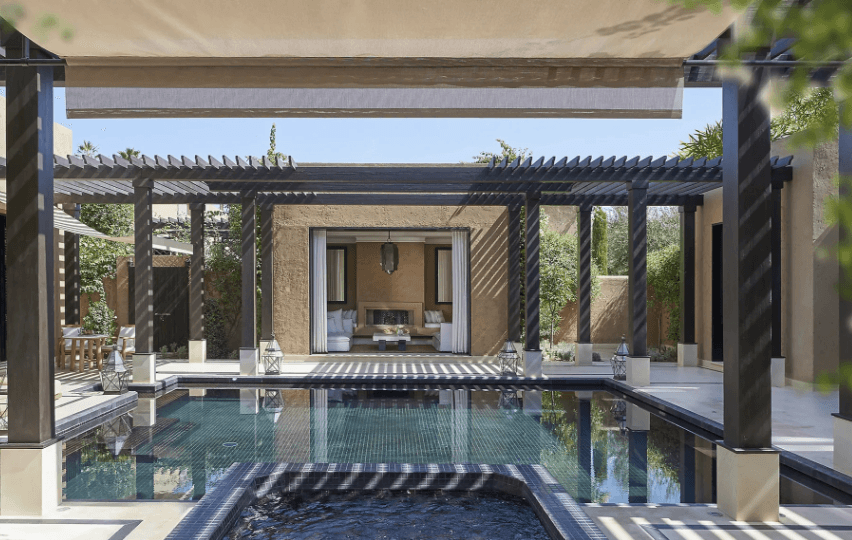
Mandarin Oriental, Marrakech
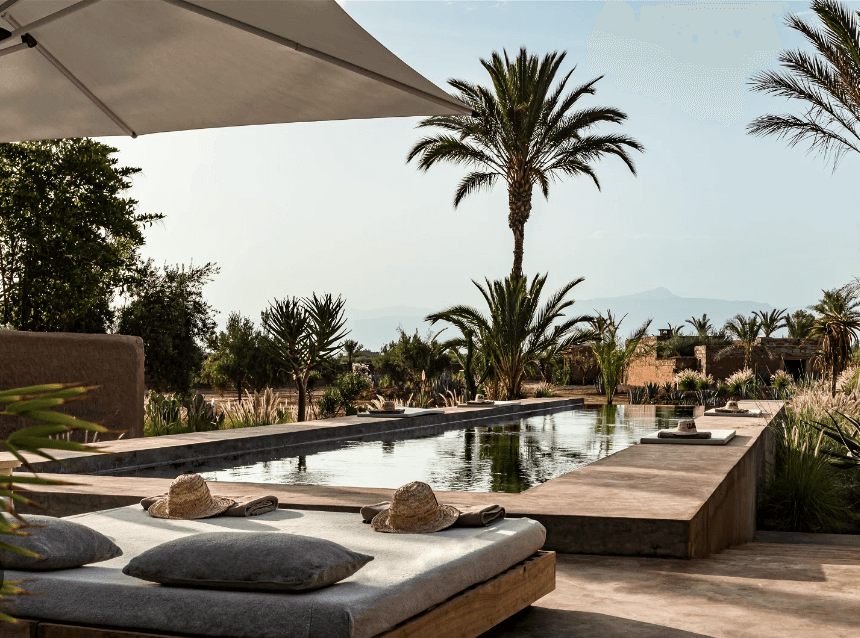
Mandarin Oriental, Marrakech
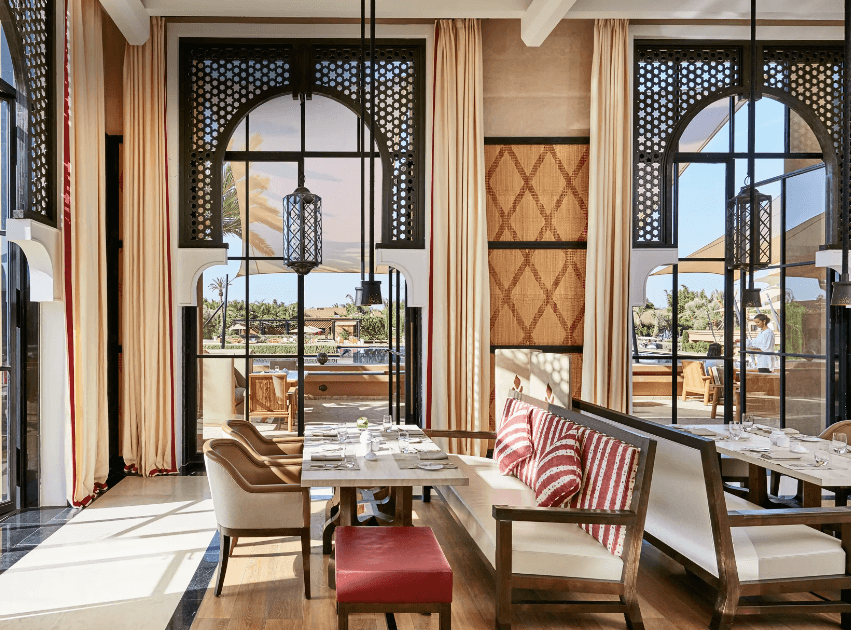
Mandarin Oriental, Marrakech
Mandarin Oriental, Marrakech
The hotel provides a resort experience and is located a 10-minute drive outside of the Medina. If you can drag yourself away from your own pool and the oasis-like gardens, a complimentary shuttle will take you to the bustling Djemaa el-Fna square.
The local surroundings are primarily golf courses, but for a taste of culture, the Museum of African Contemporary Art is right next door. The hotel provides a resort experience and is located a 10-minute drive outside of the Medina. If you can drag yourself away from your own pool and the oasis-like gardens, a complimentary shuttle will take you to the bustling Djemaa el-Fna square. A parade of palm trees welcomes you to the main building, which includes the reception, two slick restaurants (Shirvan and Ling Ling) and seven suites. French interior designers Patrick Gilles and Dorothée Boissier have embraced a relaxed but exquisite Andalusian-Arabic aesthetic, complete with curving alcoves, muted marble, and towering oak doors. Floor-to-ceiling windows flood the public rooms with light, creating an unexpected yet successful departure from traditional Moroccan design. The desert-toned buildings imply that the gardens are the actual stars. Walkways lined with aromatic olive, orange, and almond trees, as well as 100,000 multi-colored roses, provide several routes around the various ponds and large central pool, past the sand-colored cottages, vegetable garden, and massive spa complex. Staff here go above and above, as one would expect of a Mandarin Oriental hotel. Each villa has a butler, and any requests for buggies, dinner reservations, or help with your hot tub may be handled by a short Whatsapp message. Exact coffee preferences are memorised during breakfast, and personnel are always ready to provide a local recommendation.
This is a full-fledged resort experience, with a massive main pool (typically vacant because most visitors stay in their villas), two tennis courts, four restaurants, and a running track. Excursions to the Atlas Mountains, cookery workshops, and Medina tours can all be scheduled. The latter are certainly worth booking, and include visits to neighbourhood communal bread ovens and the city's secret terraces. The distinct spa building was inspired by Andalusia's cathedrals and old mosques, and it's a true wellness temple, complete with two marble hammams, a large indoor pool, yoga studio, beauty salon and gym. Six bumper-size treatment rooms offer a relaxing environment for cleanses, wraps, and massages with argan oil and orange flower. The hotel's store is a pleasant surprise, stocked with products from emerging local designers rather than the usual big-name brands. The hotel does not sell rooms, instead offering seven entry-level suites in the main structure, each with a plunge pool with views of the grounds and the Atlas Mountains beyond. These are ideal for those with limited mobility or those who prefer to be close to the restaurants and reception. The majority of visitors, however, come to stay in one of the 54 villas spread around the 10-acre grounds, which range in size from one to four bedrooms. Each is intended as a little riad and built around a big private pool, complete with an outdoor kitchen, dining table, sofa seating, and fireplace.
Moving indoors, you may enjoy your own spa day in the marble bathroom, which features a super-sized circular tub, steam room/shower and chaise lounge, as well as Diptyque goods. This leads to a central bedroom, which is mostly taken up by a big bed and has French doors that open into a bubbling hot tub. On the opposite side is a sophisticated living room with Moroccan delicacies left every night, though most guests will undoubtedly stay outside. Classic cream-colored linens and dark wood are used throughout, while hand-woven rugs from Rabat and tadelakt plastered walls carved with Berber figures add a feeling of place. Make reservations at Shirvan, the Silk Road-inspired restaurant run by Michelin-starred Paris chef Akrame Benallal. This is fusion food at its best, innovative but harmonious. Enjoy sharing dishes of caramelised lamb tacos with honey and raïta, as well as tandoori roasted cauliflower with tahini, orange blossom, and almonds, best served with cheddar cheese naan. Pistachio cake for custard is a must-order. Hakkasan's Ling Ling, which serves delicate scallop siu mai and honey-glazed black fish, also attracts beautiful young Moroccans. On most nights, you can expect DJs and dancing. The pool café serves traditional but delicious resort fare such as club sandwiches and lobster rolls, and guests can even reserve a private meal set in the hotel's vegetable garden. For pre-dinner cocktails, head to the Tent, a cocktail/lounge bar beneath canvas.
Breakfast at all Mandarin Oriental hotels is extravagant, and Marrakech is no exception. Shirvan's buffet includes freshly baked pastries (from apple-stuffed Danish pastries to wholegrain croissants), madeleines, daily changing cakes, cookies, cold cuts, cereals, and luscious fruit.
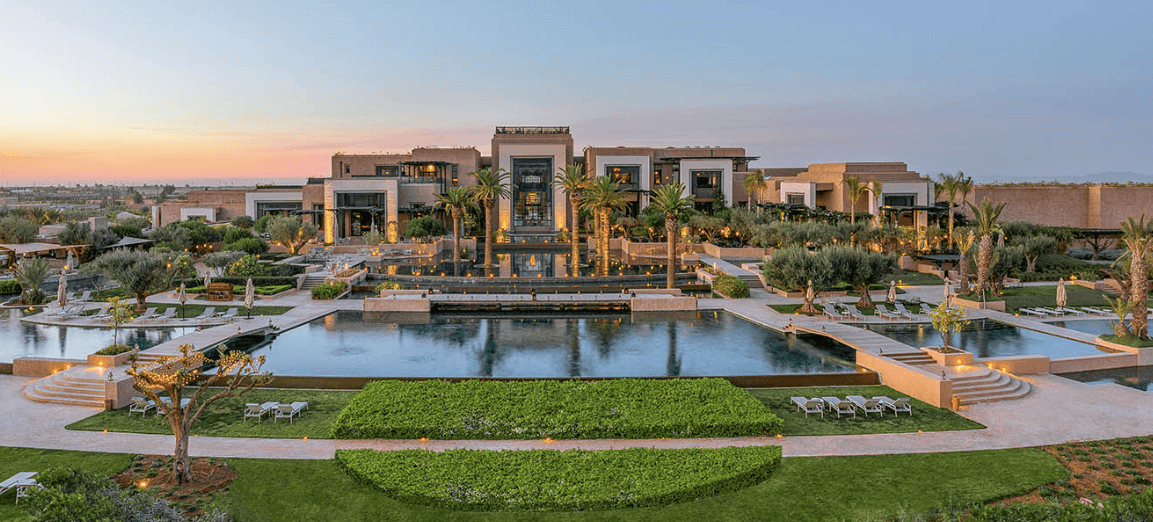
Fairmont Royal Palm Marrakech
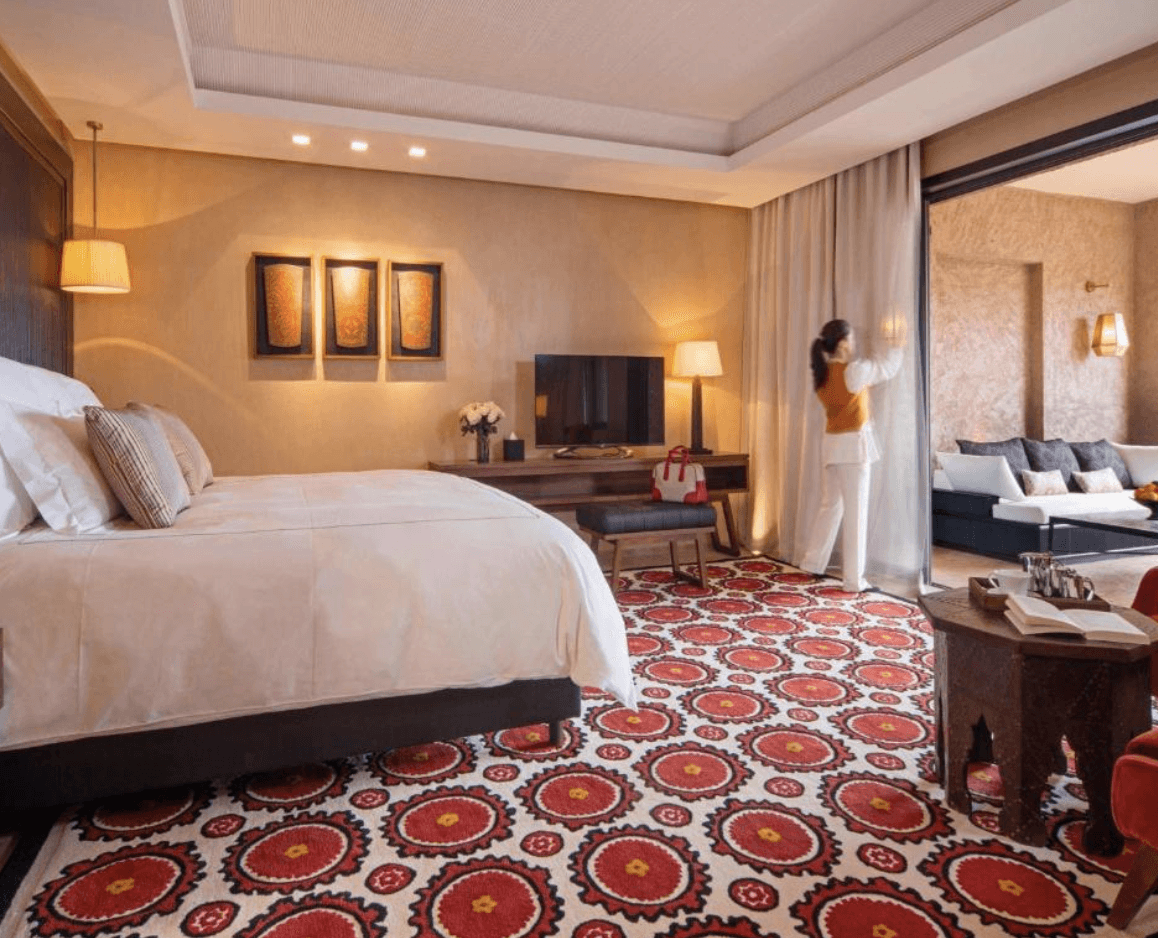
Fairmont Royal Palm Marrakech
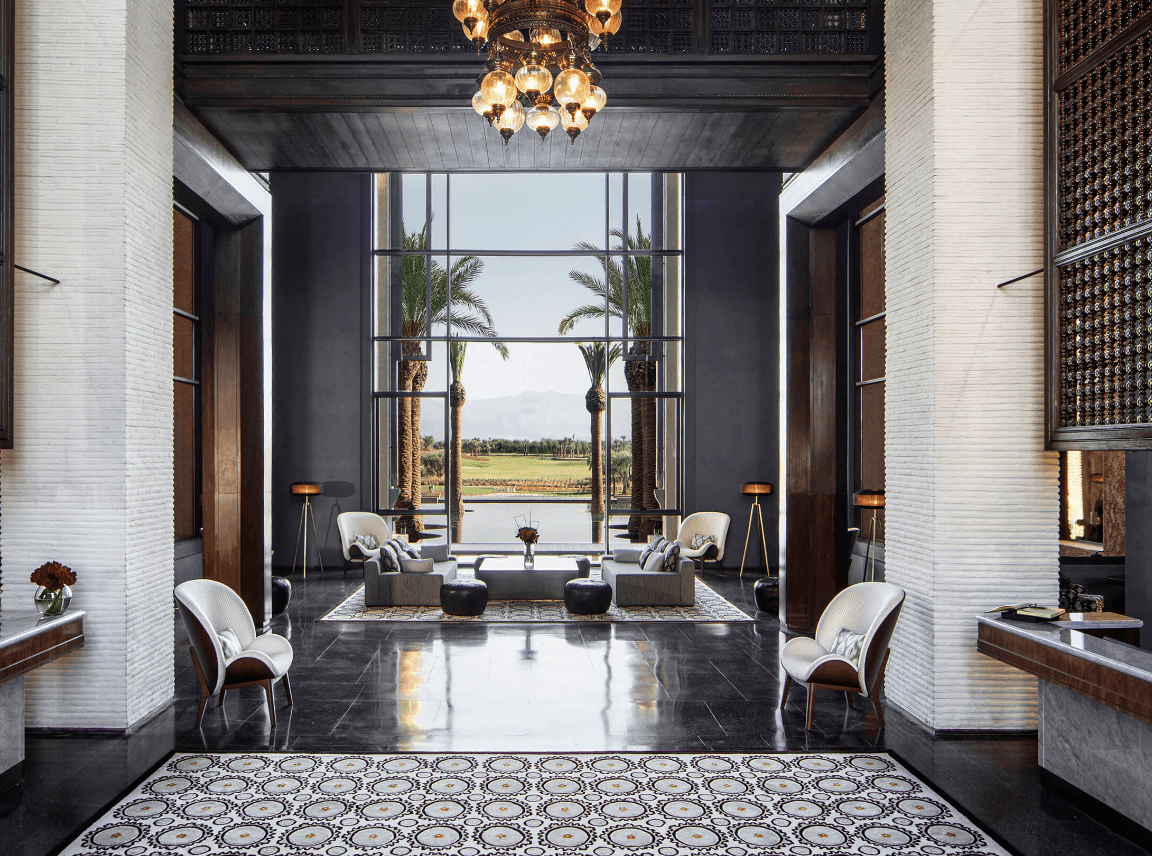
Fairmont Royal Palm Marrakech
Fairmont Royal Palm Marrakech
Beautifully set on a 231-hectare estate in Tameslouht, eight miles (12 km) from Marrakech. The resort's lone 18-hole golf course was constructed by Cabell Robinson, a prominent American course architect. Regular free shuttles make the 20-minute trip into the Medina. The Fairmont's earthy, apricot-colored hub, which is made up of interconnected cubes, is reminiscent of the ksars (fortified villages) found in the southern oasis. Sensitive to the desert climate, the stunning interiors employ a clever play on light and shade. Huge picture windows expose terraced pools from which tall palms emerge, giving the sensation of being at the edge of an oasis. The towering halls let air to flow as light pours through moucharabieh screens and archways, creating spectacular views. A number of beautifully furnished bars and eateries line either side of the entrance. Marilin Spataro, interior designer, creates a richly layered contemporary appearance by combining luxurious materials and textures with the best of Moroccan workmanship. Excellent. The lake-like pool runs around the front of the property adjacent to the bar and three restaurants, but situated down a level to allow seclusion to bathers. The state-of-the-art sports complex (with four tennis courts and two squash courts) and 3500-square-metre spa both have their own pools, allowing guests to relax for the day, while the 72-par, 18-hole golf course provides full country club facilities. Private coaching and bespoke programmes are available, and an army of 400 well-trained personnel works tirelessly to ensure guests have a pleasant stay. The 124 apartments include breathtaking Atlas views, private garden patios or balconies, and floor-to-ceiling sliding doors that bring the outside within. The smallest Deluxe Suites measure 72 square metres and have an elegant living room, a light-filled bedroom, a spacious marbled bathroom and a dressing room. Like the public spaces, the décor incorporates Moroccan crafts into a contemporary scheme that combines fascinating textures and exquisite skills. In addition, there are ten fantastic two-bedroom villas with their own lovely, private gardens, pool, and grilling deck. The quality, size, and style on offer are excellent. Few things are more pleasant than breakfasting on Le Caravane's patio with views of the pools and gardens. You'll need days to try everything on offer, from the home-baked harcha bread to the sweet cakes, cured meats, and savoury counter stocked with salads and smoked salmon.
Guests can enjoy light Medi-Moroccan meals in L'Olivier, an al fresco poolside restaurant, for lunch and a royal Moroccan feast in Al Aïn for dinner. The jazz bar, with its smouldering lighting and red velvet sofas, is a highlight, and for once, the cocktails (created by Erik Lorincz of the Fairmont's flagship Savoy Hotel in London) match up to the setting.
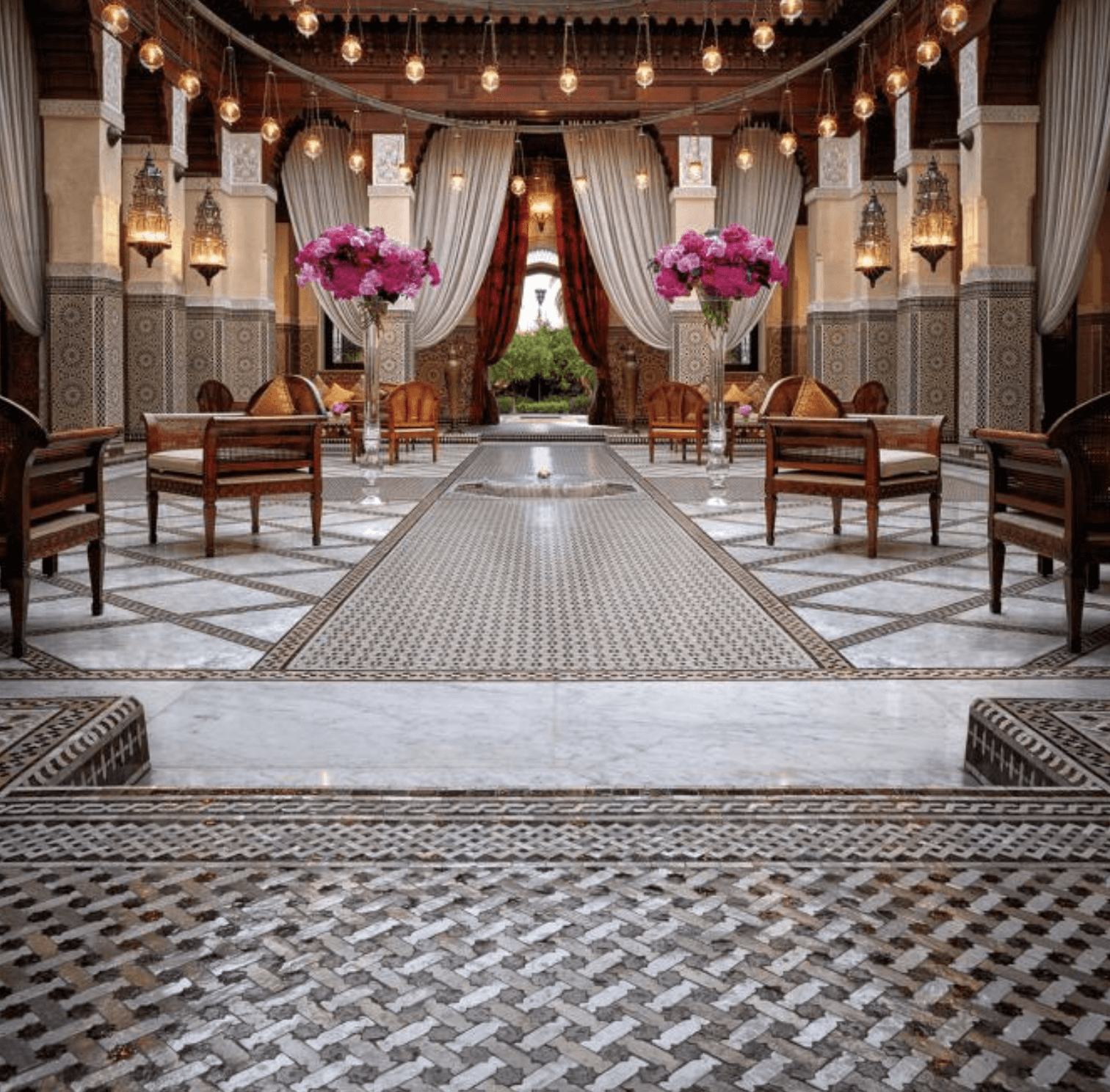
Royal Mansour Marrakech
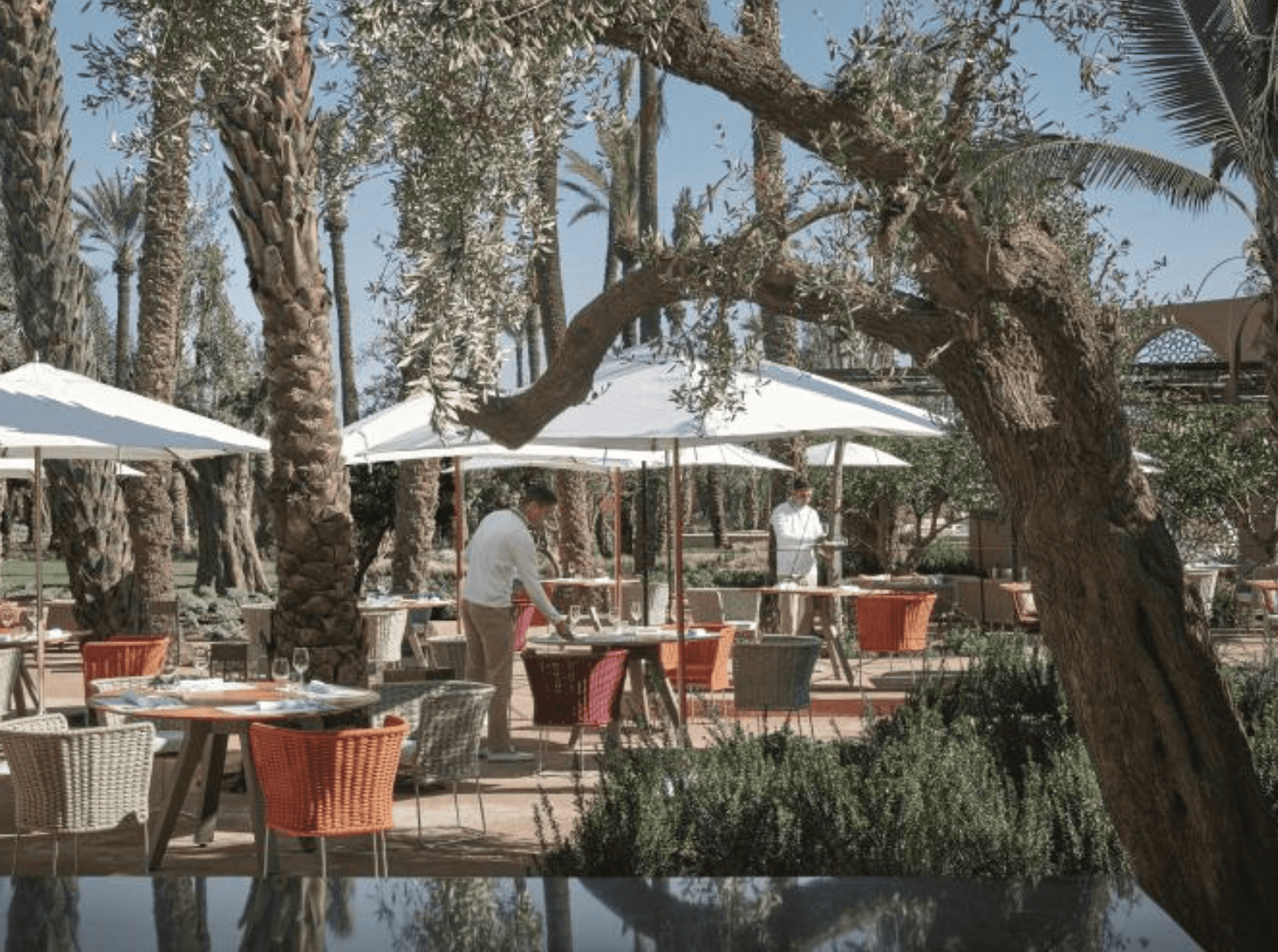
Royal Mansour Marrakech
Royal Mansour Marrakech
Ideally located in Hivernage on the western outskirts of the medina, between a public park and the historic Koutoubia mosque. The hotel is so discreet that it goes unnoticed until you pass through the security perimeter and enter beneath the spectacular triumphal arch. You can walk to the souks and Djemaa el-Fna in 15 minutes, or take a five-minute cab ride to Gueliz's trendy restaurants. Even at the airport, you're whisked through customs like a VIP in a special express lane and driven to your hotel in a Bentley.
The Royal Mansour, the King's own hotel, is a tribute to Moroccan craftsmanship and hospitality. Everything here is the best version of itself, and every inch of the space showcases the country's finest crafts, from sparkling zellij (geometric mosaic) walls to perfumed cedarwood ceilings and patios covered in elaborate stuccowork that climbs the walls like flowering creepers. Similarly, rooms are lavishly outfitted with rock crystal lamps, silver-inlaid tables, engraved glass screens, thick silk carpets, handloomed damask and jacquard draperies, and Baccarat chandeliers. It is a splendid show of Morocco's love of material, pattern, and texture, and the end result is both spectacular and strangely intimate. The Royal Mansour, the King's own hotel, celebrates Moroccan artistry and hospitality. Everything here is a better version of itself, and every inch of the area highlights the country's finest crafts, from shimmering zellij (geometric mosaic) walls to fragrant cedarwood ceilings and patios covered in intricate stuccowork that climbs the walls like flowering creepers. Similarly, the rooms are elaborately decorated with rock crystal lamps, silver-inlaid tables, engraved glass screens, thick silk carpets, handloomed damask and jacquard drapes, and Baccarat chandeliers. It is a stunning display of Morocco's love of material, pattern, and texture, with the overall effect being both majestic and strangely personal.
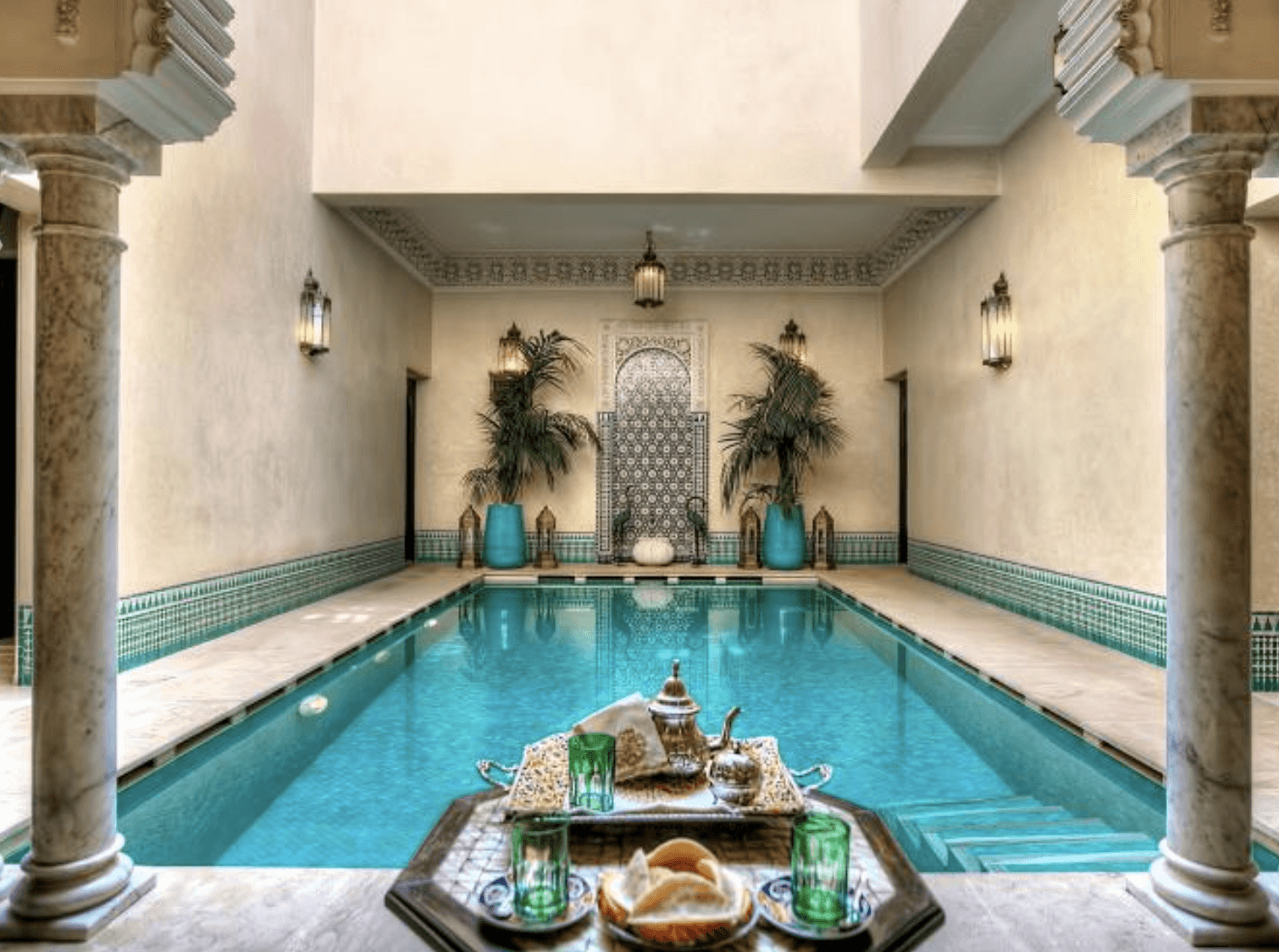
Riad Kniza
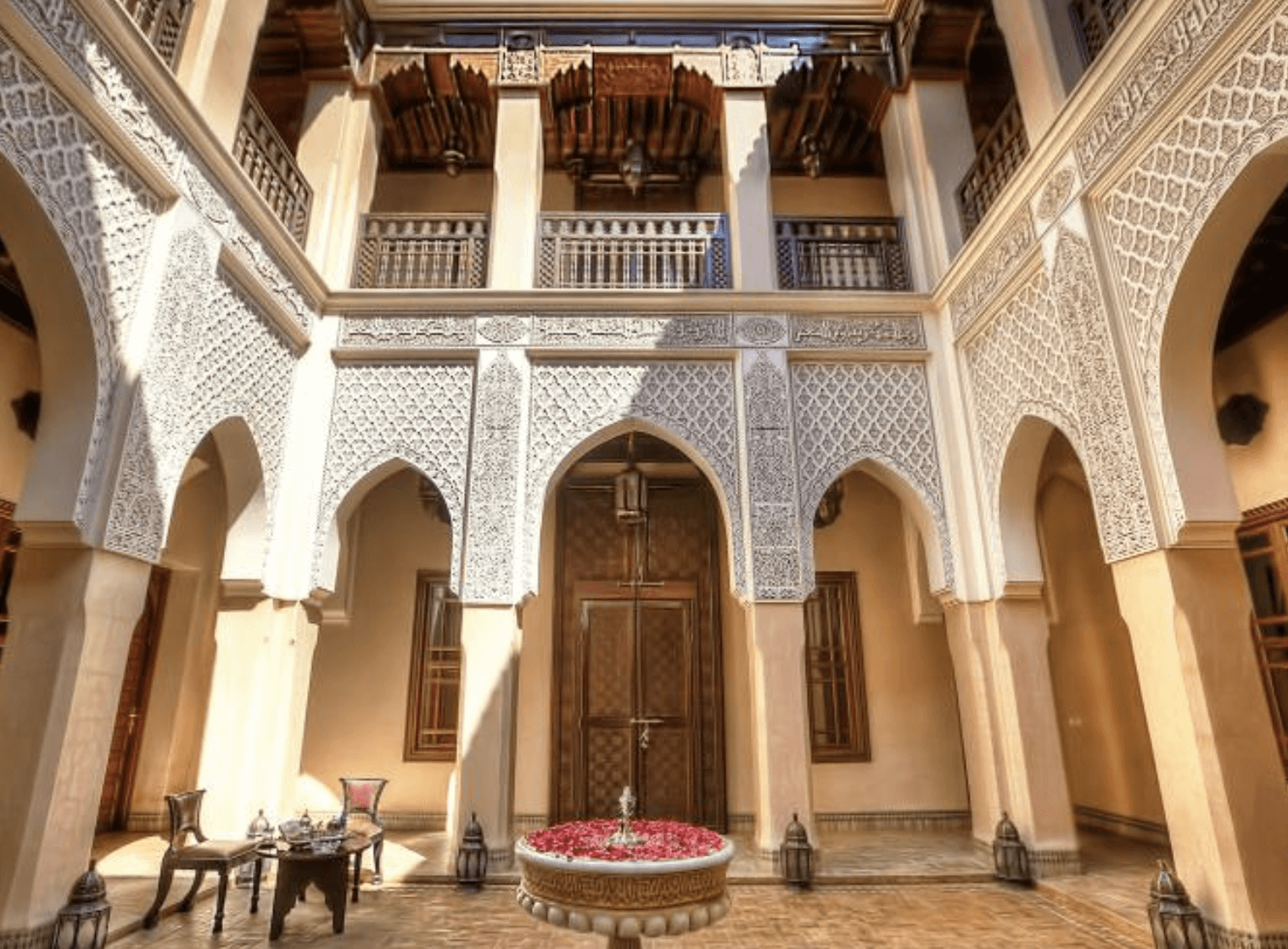
Riad Kniza
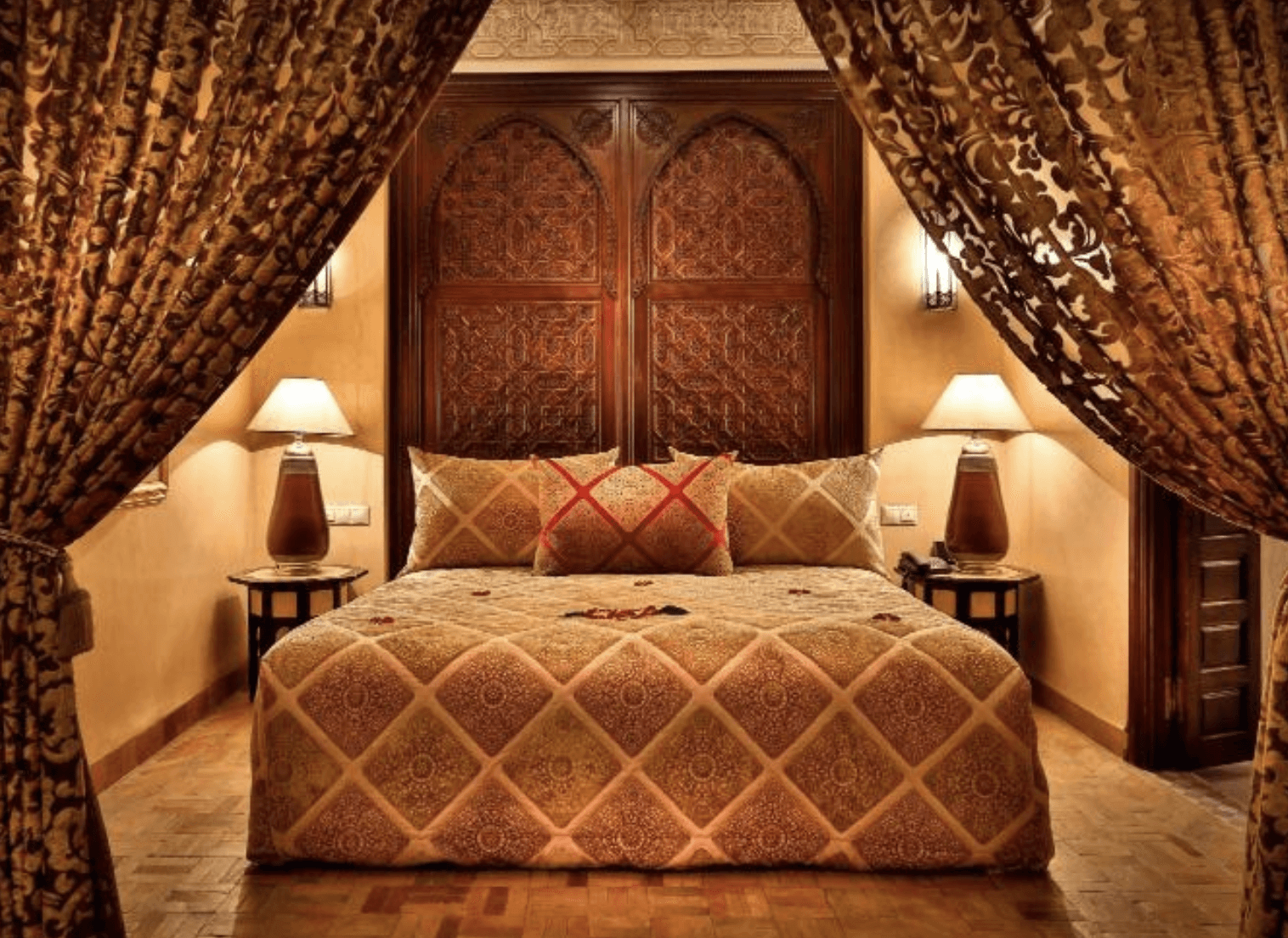
Riad Kniza
Riad Kniza
Extremely nicely located immediately inside the Bab Doukkala gate, midway between the Djemaa el-Fna and the Ville Nouvelle (New Town), which includes the Jardin Majorelle and the new Yves Saint Laurent Museum. Unusually for Marrakech, the home is easily accessible, with taxis available at Bab Doukkala and Dar el-Bacha. Riad Kniza, run by seasoned antiquarian Mohammed Bouskri, is a completely authentic riad residence and guesthouse. The Bouskri family has owned the house for nearly 200 years, and it has been repaired by some of Morocco's most experienced craftsmen. Set around three beautifully stuccoed and tiled patios, one of which has a big pool, the lofty salons, richly painted bhous (seating alcoves), and peaceful patios make no apologies for decorative excess.
Haj Bouskri's exquisite antiques, Berber rugs, crushed velvet-silk sofas, and embroidered drapes give depth and personality to this creative canvas, giving the space the rich appearance of a luxurious Marrakshi home. In the winter, fires warm the book-lined library and comfortable drawing room, while in the summer, mint tea is served in courtyard bhous (seating nooks) and on the plant-screened terrace with its panoramic views. With star clients on its roster, the treatment here is appropriately subtle, sensitive, and covert. Meals are delivered whenever and wherever you choose, there's a pool, spa, and hammam for relaxing, and Haj Bouskri's professional excursions have guided countless VIPs to the souks' best treasures. Across the lane, the family has opened another riad, which displays their own outstanding collection of Moroccan antiques and craftwork, as well as high-quality contemporary examples for sale. Haj Bouskri has filled Riad Kniza's 11 rooms and suites with incredible pieces, including painted wedding chests, gold canopies, carved cedarwood screens, silk and woollen rugs, Berber wedding blankets, and Oriental paintings. Some have magnificent king-sized beds beneath finely carved plaster domes, while others stand on high platforms veiled by silk or gossamer curtains.
The Junior and Senior suites resemble tiny apartments, and the Royal Suite Bahia is the size of a small house. At this level, you can expect vast seating spaces outfitted with incredibly comfy Moroccan sofas and gorgeous fires. The marble-clad bathrooms are similarly well-appointed, with his-and-hers sinks, heated towel rails, and bathtubs, with the exception of the Ambar Suite, which features a rain shower. Riad Kniza, like any self-respecting Moroccan household, treats food as an occasion, whether it's a delectable breakfast of homemade pastries, yoghurt, eggs, and pancakes served on the roof terrace, light lunches of rose-scented carrot salad, or multi-course evening feasts.
The latter begins with cocktails in the courtyard, where Gnawa musicians perform traditional Moroccan love poems, and then moves to the romantic dining salon, where a variety of dishes are served, including a six-dish Moroccan salad starter, a savoury soup (lentil or chickpea), a pigeon pastilla (pigeon in layered pastry), a delicious, slow-cooked tagine or couscous, and a French-style dessert.
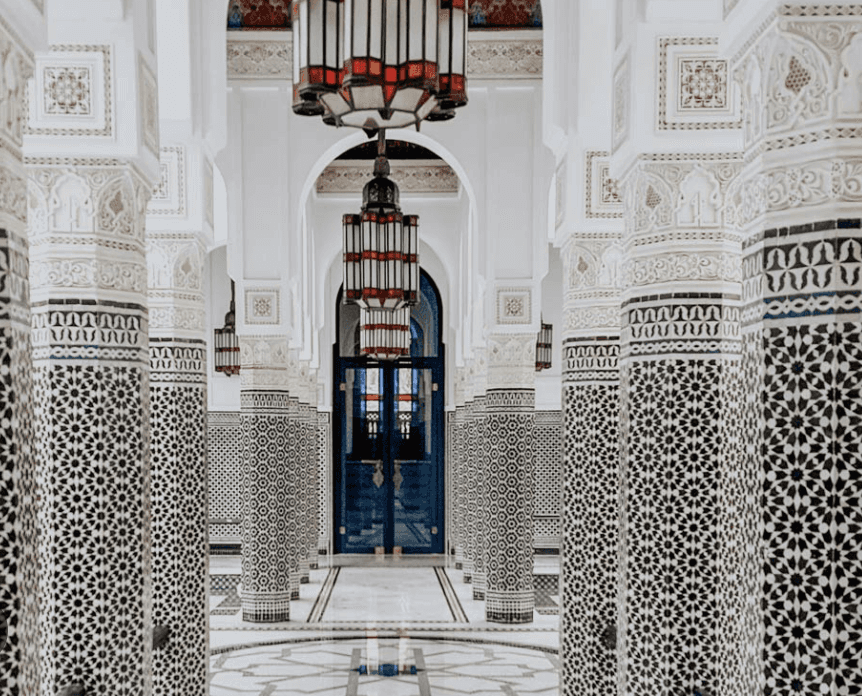
La Mamounia
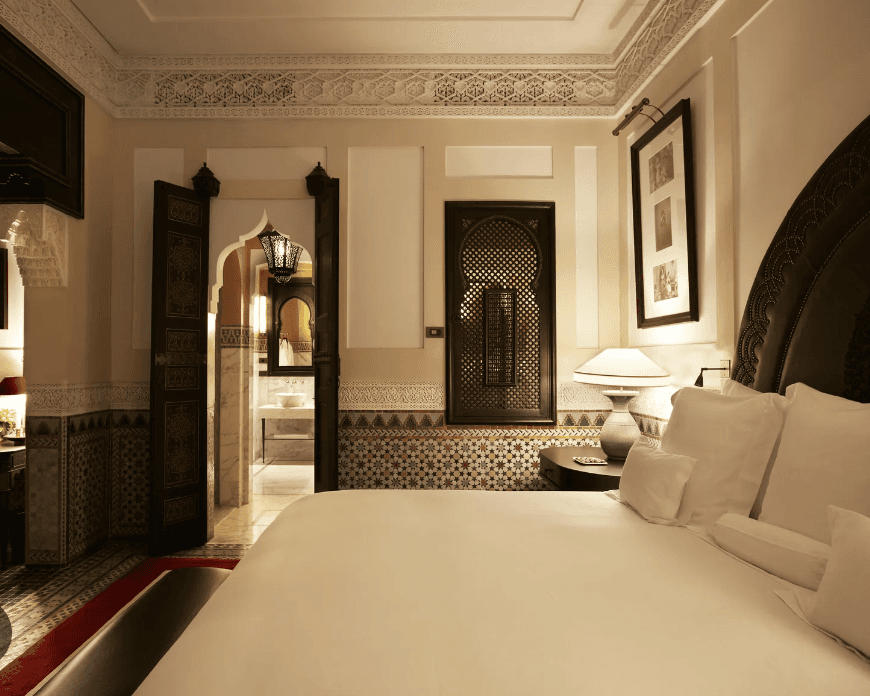
La Mamounia
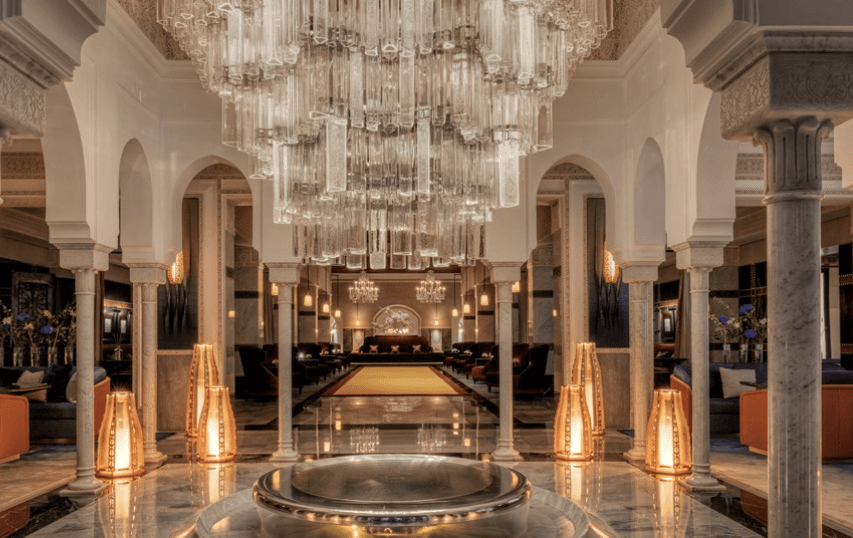
La Mamounia
La Mamounia
La Mamounia, like one of Marrakech's enormous gates, is located on the outside of the medina and is a key landmark in the city. You can see the Koutoubia minaret from the garden, walk to Djemaa el-Fna in five minutes, or have a caped doorman hail a cab to take you to the new town, Gueliz, in five to ten minutes. Since its opening in 1923 as a large art deco railway hotel, this public palace has welcomed visitors with unparalleled Moroccan hospitality. No doubt, it has historical significance, but La Mamounia is more than just a history hotel; it is a platform for Marrakech's cultural life. The Marrakech Film Festival takes place here, as does the globally renowned 1-54 African Art Fair. Artistocrats and celebrities marry beneath palm trees in the 18th-century garden, while movers and shakers conduct business in Le Bar Majorelle or over lunch at the pool pavilion. This social whirl takes place against a lavish indoor backdrop that combines haute modern luxury with the hotel's characteristic art deco design. With approximately 700 personnel (an average of four per room), La Mamounia is well-known for its courteous service. When you arrive, you will be greeted with hot towels, orange blossom-infused milk, and dates, while your room will be adorned with roses, spiced cakes, and fruit bowls. There are four lovely bars, one in the garden under the stars, four beautiful restaurants, and an amazing French tea salon. Then there's the big underground spa with Marrakech's most Instagrammable pool, a hair salon, a mini-mall with local and designer stores, a garden gym, a retro games room for teens, a luxurious cinema, tennis courts, and a large palm-framed pool. In brief, you'll find everything you need for a great time. There are 135 rooms, 71 suites (four of which have two beds), and three riads with three bedrooms apiece. Entry-level Classic and Superior accommodations are luxurious but quite standard, so if your budget allows, consider upgrading to a Deluxe room or higher. The latter include balconies, the best of which overlook the beautiful gardens and the Atlas Mountains. All of them are decorated with rich Moroccan crafts, including elaborate zellij (mosaic) tiling, latticework screens, and polished tadelakt (plaster) bathrooms. These themes are complemented by gorgeous art deco furnishings and enormous king beds. Bathrooms have a jewel-like appearance, and have tiled and marble finishes. Only larger rooms include a bath. The higher you go, the more amenities you'll get: extra lounges, double balconies, dressing rooms, and, in the Exceptional suites, front-row views of the Koutoubia. The restaurants, elegantly restored by the Jouin Manku design firm, are a success. Each has its own distinct style, ranging from the casual chic, gold and green Italian trattoria that opens onto the garden to the high luxury of the pan-Asian fine dining restaurant and the sultry Churchill Bar, now reimagined as a wood-paneled railway carriage serving champagne and caviar at a sculpted black marble bar. The selection of Michelin-starred chef Jean-Georges Vongerichten for the Italian and Asian restaurants was inspired. As an international traveller, his menus reflect the variety and sophistication needed by La Mamounia's broad customer while remaining faithful to each restaurant's theme and creating extremely flavorful food. Similarly, the Moroccan restaurant, tucked apart in the garden, serves traditional meals as well as new creations by Moroccan chef Rachid Agouray. French bistro meals and homemade ice cream are served all day at the Pool Pavilion, which is still famous for its Sunday lunch and massive breakfast buffet. The latter contains mountains of viennoiserie, charcuterie, cheese, yoghurts, cereal, fruit, and eggs in every conceivable manner. Or simply stop in for tea beneath the sparkling Lasvit chandelier at the Pierre Hermé salon, a popular treat among well-heeled locals.
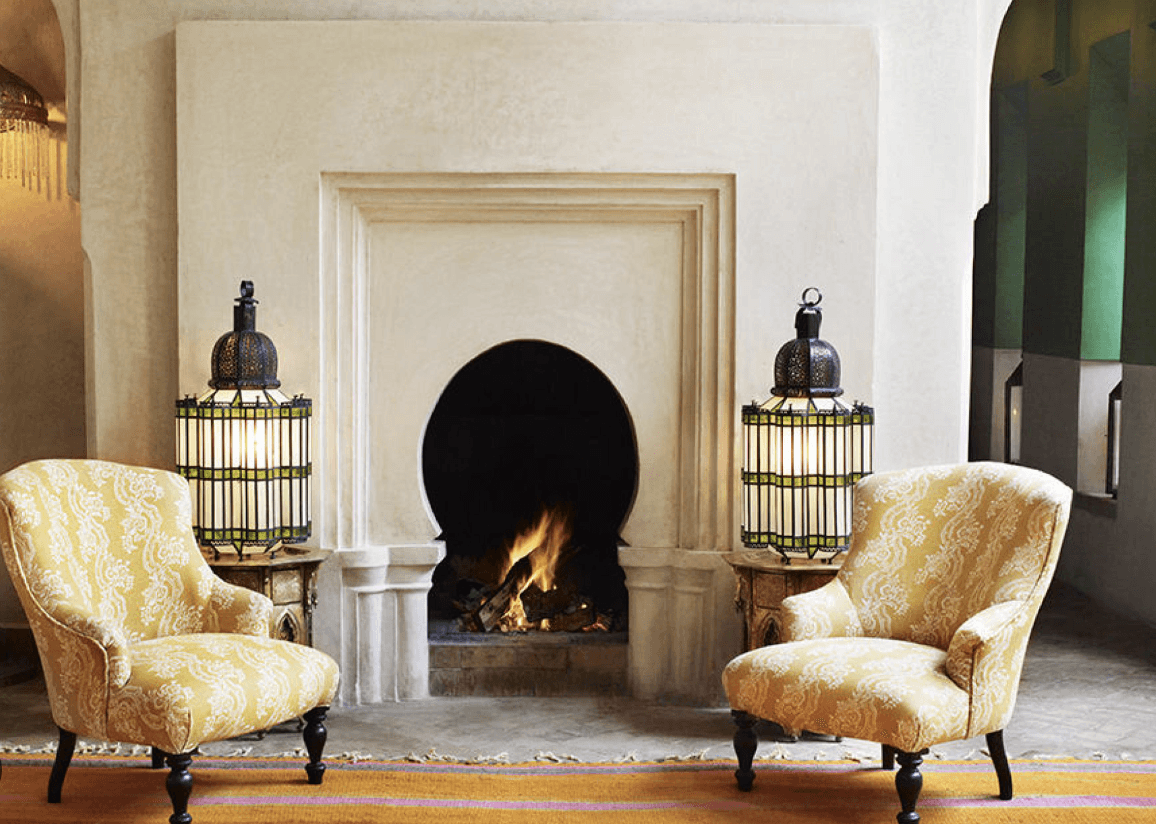
L'Hôtel Marrakech
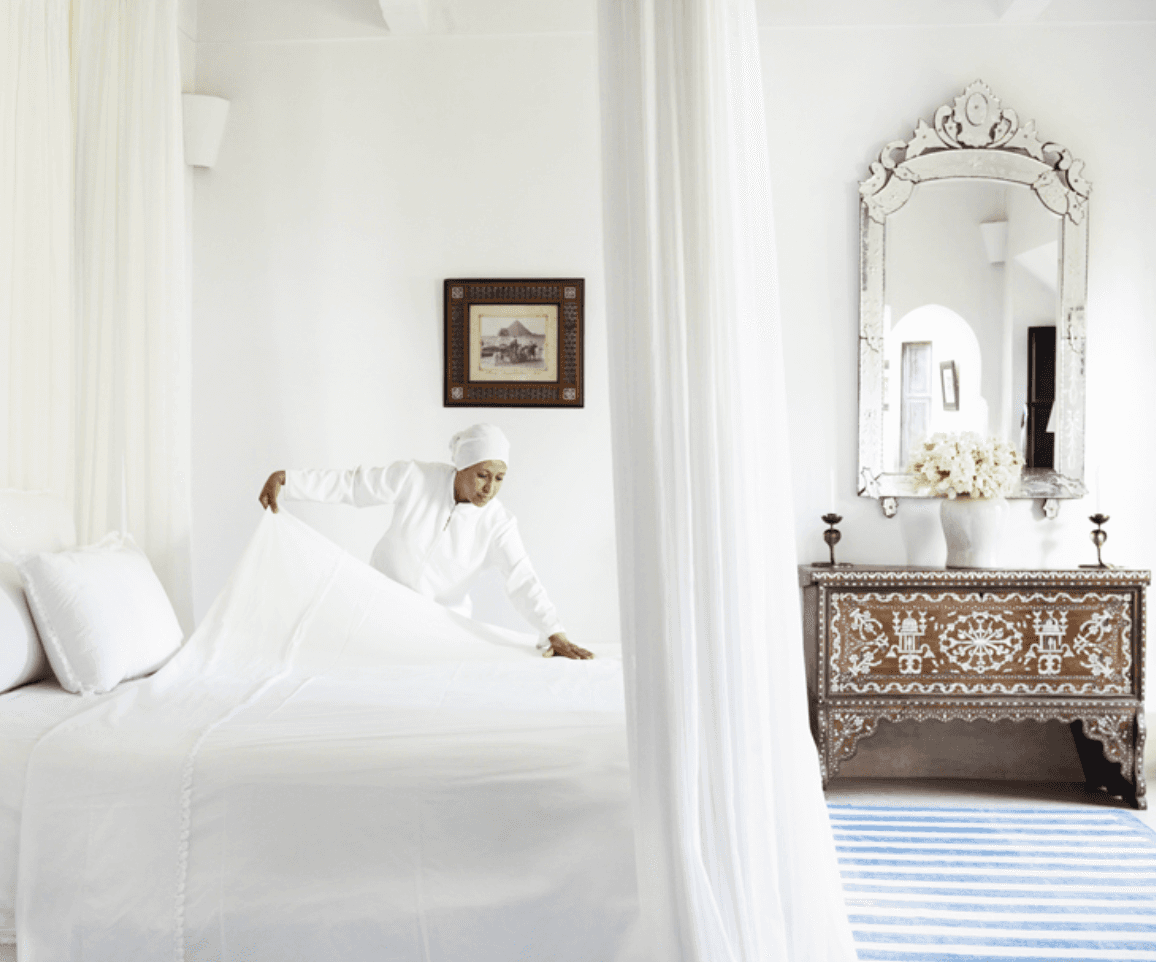
L'Hôtel Marrakech
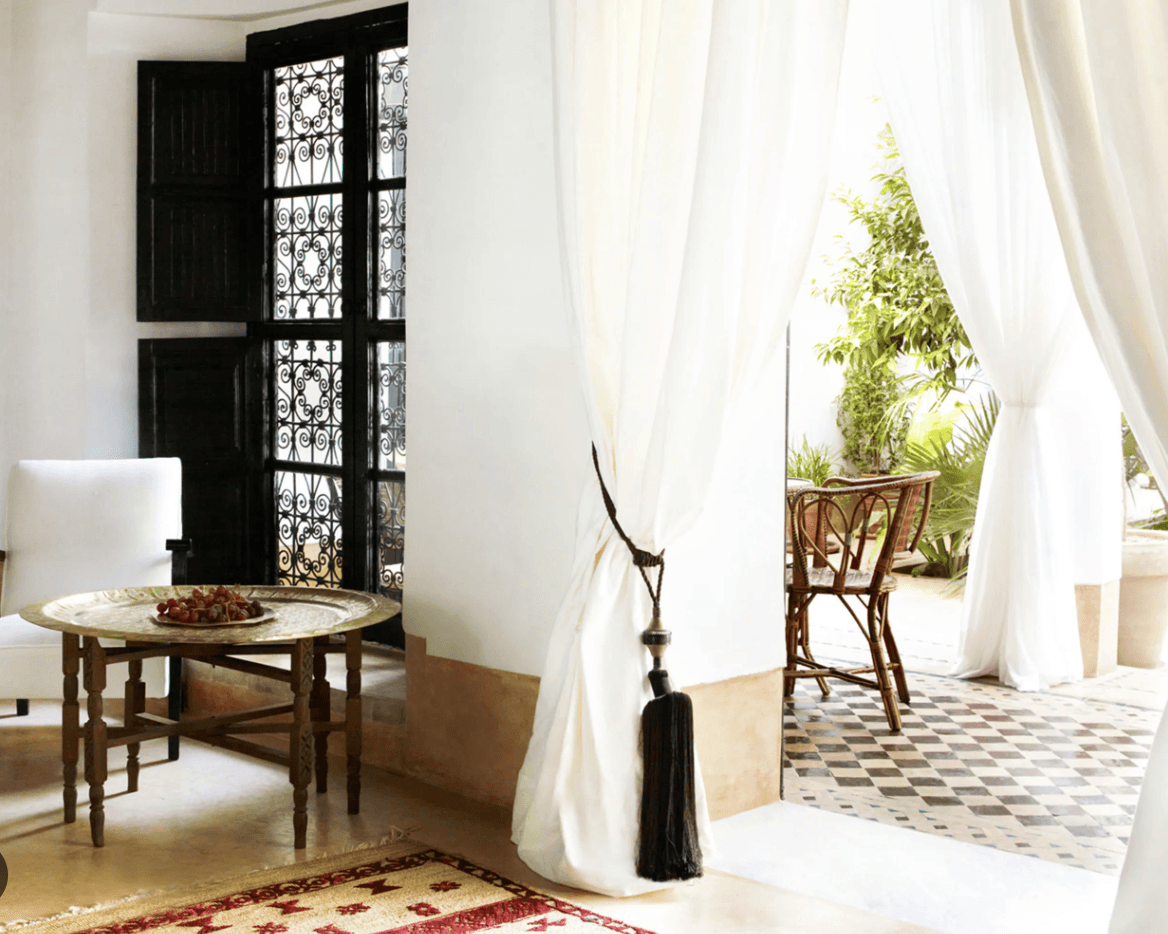
L'Hôtel Marrakech
L'Hôtel Marrakech
Buried in a winding derb in the traditional neighbourhood of Bab Doukkala. A bustling neighbourhood market is just steps away, and the Djemaa el-Fna is only a 15-minute walk. Taxis are accessible in Bab Doukkala. Good taste is as much about what is left out as what is chosen, and Conran's keen design eye has created an ambiance of old-school glamour with a pared-back contemporary sensibility. This period palace's harmonious proportions - its double-height arches, deep balconies, rambling roof terraces, and thickly planted patio - reflect a spirit of generosity and quiet sophistication, while rare artworks, hand-loomed carpets, and signature fabrics add layers of thoughtful luxury and personality. It exudes a timeless Deco elegance that relaxes guests and inspires spontaneous aperitif parties on the roof terrace or long and important chats over the zinc-topped bar, while Louis Armstrong croons in the background. Luca Ravera, the manager, sets a sophisticated tone in the house, conversing with visitors in five languages and offering information on the Marrakech scene. He is assisted by a team of eight people who take great care in their work, arranging tables in fine linens, transporting silver buckets of ice to the roof, and discussing some of the finer features of Moroccan food and culture. The garden is probably the best aspect of the house. Through the floor-to-ceiling French windows in the dining room, it appears to be a lush Zuber wall print, and it also serves as a natural screen for the 10-meter-long, heated saltwater pool. In addition, there is a hammam (accessible when the entire property is rented) and a jigsaw of roof terraces adorned with jasmine and potted roses. Massages can be provided in your room upon request. With only five suites, staying here feels like visiting a beautiful private house, which is precisely what a riad is supposed to be. Tangier and Asilah are the smallest suites, while Zagora, Fez, and Casablanca span the whole width of the house and each have their own private terrace or balcony. All rooms include romantic four-poster beds draped in romantic voile curtains and are decorated with artworks from Jasper's collection, such as sparkling Indian miniature paintings, ornate, inlaid Syrian mirrors, and organic Art Deco lights by Daum Frères. Ear plugs for light sleepers, fresh fruit, dates, and a generous supply of complementary amenities are among the thoughtful touches in the light-filled tadelakt bathrooms, three of which include bathtubs. If you can bear to leave the cloud-like cosiness of your bed, eat breakfast at linen-covered tables on your private patio or beneath the pergola on the roof. You won't have to wait long for your coffee, which arrives immediately in a wicker-lined thermos. A continental or Moroccan option is available, along with a variety of eggs. Bouchra, the house dada (chef), prepares a unique and diverse selection of Moroccan cuisine. Vegetarian meals are well represented, including a fantastic pea and artichoke tagine; otherwise, there are fish pastillas and a beef and quince tagine with the deepest, sweetest flavour profile. Beautiful table decorations, crackling flames in the winter, and mellow jazz music create a soulful environment.
Conclusion
Marrakesh is a timeless gem, with the charm of its bustling streets and the hospitality of its people creating a unique experience for visitors. Marrakesh provides a cultural and discovery experience that includes visiting the Medina's labyrinthine lanes as well as admiring the architectural treasures of its palaces and mosques. As our review of the city's greatest hotels reveals, Marrakesh perfectly blends elegance and authenticity, ensuring that every guest has a wonderfully unique stay. Whether enjoying in the luxurious amenities of a five-star resort or immersed in the charm of a traditional riad, Marrakesh's accommodations reflect the city's distinct blend of tradition and modernity. As travellers leave Marrakesh, they take with them memories of a city that captivates the senses and leaves an unforgettable stamp on the soul.

